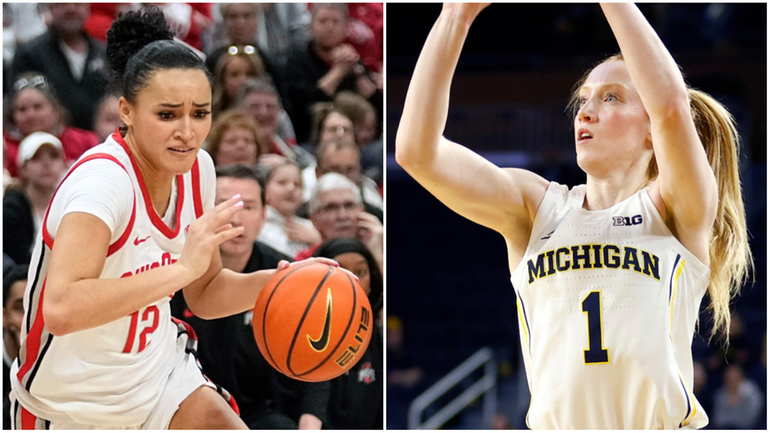Long Islanders Celeste Taylor and Lauren Hansen used the NCAA transfer portal to take control of their careers

Ohio State's Celeste Taylor, left, and Michigan's Lauren Hansen. Credit: AP / Sue Ogrocki; AP / Al Goldis
Celeste Taylor started dreaming of playing in the WNBA more than a decade ago when she worked a couple games as a ball girl for the Liberty.
Taylor, who is from Valley Stream and was a two-time Newsday Player of the Year at Long Island Lutheran, planned to declare for the WNBA draft at the end of last season, after her senior year at Duke. But when the Blue Devils lost an overtime game to Colorado in the second round of last year’s NCAA Tournament, her parents convinced her to use her COVID-19 fifth year of eligibility. And then her favorite assistant coach at Duke took a job at another school.
So, to the transfer portal she went.
Taylor landed at Ohio State, which is a No. 2 seed in this year’s NCAA Tournament. She was one of more than 1,000 Division I women’s basketball players who entered the transfer portal for various reasons last year and one of at least 865 who found new schools to play for, according to statistics on the NCAA website.
While there has been significant hand-wringing across the country from coaches and fans about how the transfer portal has hurt their game, it also has provided a much-needed chance for players to escape toxic situations or just take control of their own careers.
“Honestly, I never went into [college basketball] wanting to transfer anywhere,” said Taylor, who also used the transfer portal to move to Duke after her first two years at Texas. “Sometimes things don’t work out. I’m not one to shy away from a challenge, but when the cards are not right, I think that’s a big thing. I wanted to go somewhere for my last year where they were going to develop me.”
On Tuesday, Taylor was named one of four finalists for the Naismith Defensive Player of the Year award. On March 5, she was named the Big Ten’s Defensive Player of the Year, after leading the conference with 2.3 steals per game. Taylor has won defensive player of the year awards in two different conferences. She received that honor from the ACC last year as a senior at Duke.
With Ohio State poised to make a deep run, the exposure can only help Taylor’s stock in the upcoming WNBA draft. In the meantime, she has been able to add a master's degree in sports coaching to the psychology degree she earned at Duke.
Taylor isn’t the only local player to take advantage of the transfer portal and play at three different schools.
After stops at Auburn and Missouri, Lauren Hansen will finally play in her first NCAA Tournament game Saturday when ninth-seeded Michigan takes on eighth-seeded Kansas.
Hansen, a standout at Ward Melville under former WNBA player Sammy Prahalis-Holmes, started her career at Auburn. After her freshman season, she transferred to Missouri, where she gained national attention on Dec. 30, 2021, when she hit a shot at the buzzer in overtime to lift her unranked team to a win over then unbeaten and No. 1 South Carolina.
Hansen earned a degree in communications at Missouri but never got to the big tournament. She, too, decided to take advantage of a COVID-19 fifth year of eligibility and transferred to Michigan as a graduate student to play under Kim Barnes Arico, a former St. John’s coach who recruited Hansen out of high school.
“I think the portal is a good thing to be able to use for the right purposes,” said Hansen, who earned All-Big Ten honorable mention this season after starting 33 games at point guard. “When you have an opportunity to go to a school like Michigan, I knew it would be a winning culture and I knew I would have a good shot of going to the tournament. I wanted to get the most I could out of a one-year experience.”
Understandably, many coaches aren’t huge fans of the portal. For years, most women’s college basketball dynasties were built by getting top high school players and then — unlike the men’s game — keeping them for four years.
Now, the whole dynamic has shifted with the portal also figuring significantly into how teams are built. If you look across the sport, few teams haven’t been impacted — with players coming or leaving or both — by the portal.
Though it might take a change of mindset from coaches or some tweaks from the NCAA to get right, it only seems fair that players have a degree of freedom to take control of their careers. Why should anyone be stuck with a decision made at 17 years old? Why should players not be able to change schools when their coaches can change jobs without any repercussions?
Taylor believes that being able to play at three different schools in three different areas of the country has helped her grow as a player and as a person.
Said Taylor: “I’ve been blessed as far as learning different aspects of basketball, experiencing different systems, conferences and coaching styles. As a person, I’m from Long Island and I’ve lived in Texas, North Carolina and now Ohio. Just having that experience is pretty cool. I feel blessed.”

